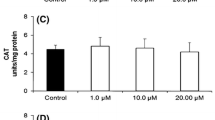Abstract
Lipid peroxidation (LPO) in rat testis and heart microsomes was compared using the ADP/Fe2+ as initiator with and without ascorbate at different concentrations. The extent of LPO was estimated by the levels of TBARS and PUFA. Without ascorbate, LPO was higher in heart than in testis despite elevated levels of catalase in heart. With increased ascorbate concentrations, a biphasic effect of LPO was observed. For a concentration ≤ 0.2 mM, ascorbate acted as pro-oxidant and increased TBARS correlated with decreased PUFA were observed both in testis and heart. Above 0.2 mM, ascorbate acts as antioxidant but differences in the rate of LPO were observed. In heart decreased TBARS correlated with increased PUFA whereas in testis TBARS only decreased, PUFA were not significantly modified. These results suggest different mechanisms in LPO initiation in the two organs. Increasing concentrations of H2O2 produced directly elevated TBARS levels in testis while a lag phase was observed in heart before the increase, suggesting that H2O2 was the essential ROS produced by ascorbate-ADP/Fe2+. The effects of scavengers such as catalase and ethanol showed an inhibitory effect on TBARS production only in testis, suggesting the role of H2O2/OH⋅ as an initiator of LPO. In heart, catalase produced a slight increase in TBARS levels whereas no modification was observed with ethanol, suggesting a possible direct activation by ADP/Fe2+ through a metal-oxo intermediate.
Similar content being viewed by others
References
Gutteridge JMC, Halliwell B: The measurement and mechanism of lipid peroxidation in biological systems. Trends Biochem Sci 15: 129–135, 1990
Yagi K: Assay for serum lipid peroxide level and its clinical significance. In: K Yagi (ed). Lipid Peroxides in Biology and Medicine. Academic Press, New York, 1982, pp 223–241
Bruna E, Petit E, Beljean-Leymari M, Huynh S, Nouvelot A: Specific susceptibility of docosahexaenoic acid and eicosapentaenoic acid to peroxidation in aqueous solution. Lipids 24: 970–975, 1989
Witting LA: Vitamin E and lipid antioxidants in free radical initiated reactions. In: WA Pryor (ed). Free Radicals in Biology. Academic Press, London, 1980, pp 295–319
Tappel AL: Vitamin E as the biological lipid antioxidant. Vitam Horm 20: 493–510, 1962
Leung HW, Wang MJ, Mavis RD: The cooperative interaction between vitamin E and vitamin C in suppression of peroxidation of membrane phospholipids. Biochem Biophys Acta 644: 266–272, 1981
Sies H, Stahl W, Sundquist A: Antioxidant functions of vitamins. Ann NY Acad Sci 669: 7–20, 1992
Palamanda JR, Kehrer JP: Involvement of vitamin E and protein thiols in the inhibition of microsomal lipid peroxidation by glutathione. Lipids 28: 427–431, 1993
Rees S, Slater TF: Ascorbic acid and lipid peroxidation: the cross over effect. Acta Biochim Biophys Hung 22: 241–249, 1987
Miller DM, Aust SD: Studies of ascorbate dependent lipid peroxidation. Arch Biochem Biophys 271: 113–119, 1989
Melin AM, Carbonneau MA, Maviel MJ, Perromat A, Clerc M: Free radical inhibitor effect of retinol after carbon tetrachloride intoxication in the rat. Food Addit Contam 7: S182–S187, 1990
Clerc M, Delacoux E: Dosage de la retinolemie par chromatographie liquide. Ann Biol Clin 45: 469–473, 1987
Peuchant E, Wolff RJ, Salles C, Jensen R: One step extraction of human erythrocyte lipids allowing rapid determination of fatty acid com-position. Anal Biochem 181: 341–349, 1989
Witting LA, Horwitt MK: Effect of degree of fatty acid unsaturation in tocopherol deficiency induced creatinuria. J Nutr 82: 19–25, 1964
Recknagel RO, Glende EA Jr, Waller RL, Lowrey K: Lipid peroxidation biochemistry measurement and significance in liver cell injury. In: GL Plaa and WR Hewitt (eds). Toxicology of the Liver. Raven Press, New York, 1982, pp 213–241
Lowry OH, Rosebrough NJ, Farr AL, Randall RJ: Protein measurement with the Folin phenol reagent. J Biol Chem 193: 265–275, 1951
Beers RF Jr, Sizer IW: A spectrophotometric assay for measuring the breakdown of hydrogen peroxide by catalase. J Biol Chem 196: 133–140, 1952
Frankel EN: Biological significance of secondary lipid oxidation products. Free Rad Res Commun 3: 213–225, 1987
Tappel AL: Protection against free radical lipid peroxidation reactions. Adv Exp Med Biol 97: 111–131, 1978
Melin AM, Carbonneau MA, Thomas MJ, Perromat A, Clerc M: Dietary vitamins A and E affect differently lipid peroxidation in rat heart and testis. J Clin Biochem Nutr 18: 19–33, 1995
Babbs CF: Role of iron ions in the genesis of reperfusion injury following successfull cardiopulmonary resuscitation. Ann Emerg Med 14: 777–783, 1985
Burkitt MJ, Gilbert BC: Model studies of the iron-catalysed Haber Weiss cycle and the ascorbate-driven Fenton reaction. Free Rad Res Comms 10: 265–280, 1990
Smith JB, Ingerman CM, Sylver MJ: Malondialdehyde formation as an indicator of prostaglandin production by human platelet. J Lab Clin Med 88: 167–173, 1976
Nishikimi M: Oxidation of ascorbic acid with superoxide anion generated by the xanthine-xanthine oxidase system. Biochem Biophys Res Commun 63: 463–468, 1975
Bodannes RS, Chen PC: Ascorbic acid quenches singlet oxygen rap-idly. Febs Lett 105: 195–196, 1979
Mukhopadhyay M, Mukhopadhyay CK, Chatterjee IB: Protective effect of ascorbic acid against lipid peroxidation and oxidative damage in cardiac microsomes. Mol Cell Biochem 126: 69–75, 1993
Niki E: Vitamin C as an antioxidant. World Rev Nutr Diet 64: 1–31, 1991
Packer JE, Slater TF, Willson RL: Direct observation of a free radical interaction between vitamin E and vitamin C. Nature 278: 737–738, 1979
Chan PC, Peller OG, Kesner L: Copper (II)-catalyzed lipid peroxidation in liposomes and erythrocyte membranes. Lipids 17: 331–337, 1982
Kawano H, Fukuzawa K, Kogure K, Terada H: Initiation of lipid peroxidation in rat liver mitochondria by chelated iron-oxygen complexes. J Clin Biochem Nutr 11: 21–30, 1991
Author information
Authors and Affiliations
Rights and permissions
About this article
Cite this article
Melin, A.M., Peuchant, E., Perromat, A. et al. In vitro influence of ascorbate on lipid peroxidation in rat testis and heart microsomes. Mol Cell Biochem 169, 171–176 (1997). https://doi.org/10.1023/A:1006801215540
Issue Date:
DOI: https://doi.org/10.1023/A:1006801215540



